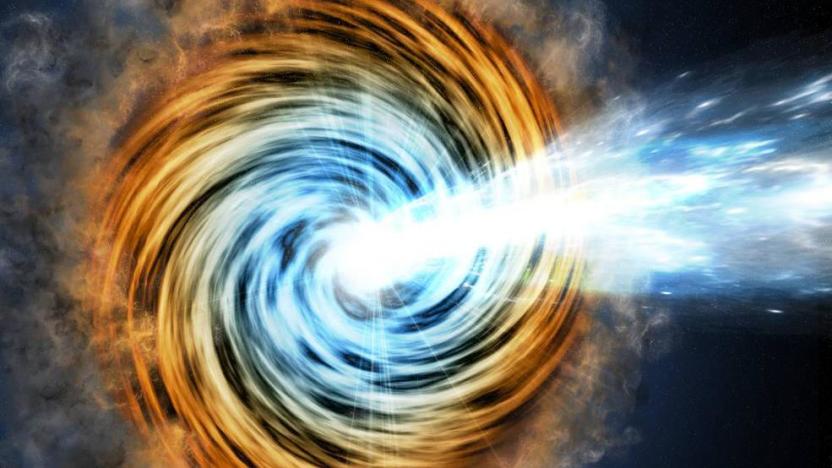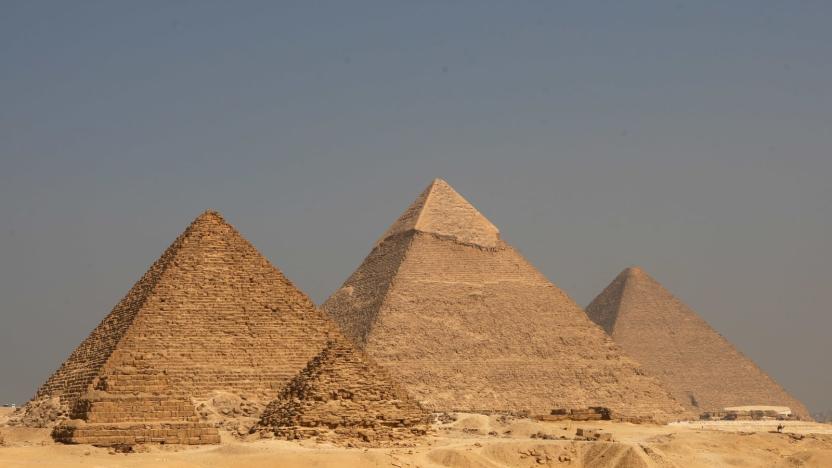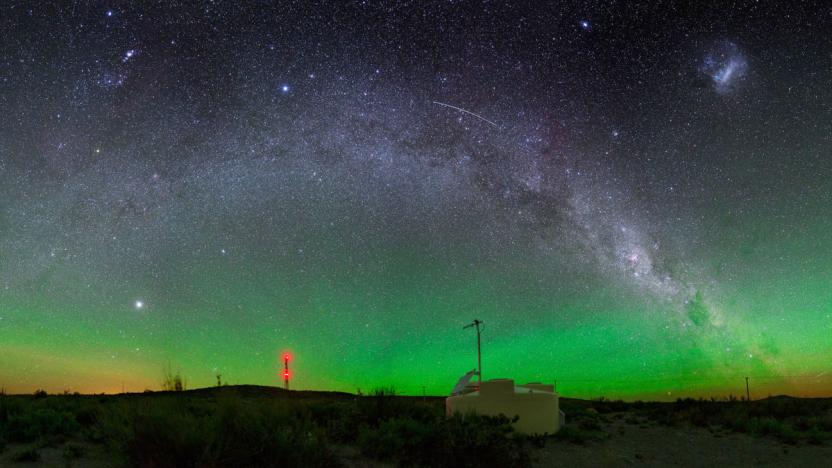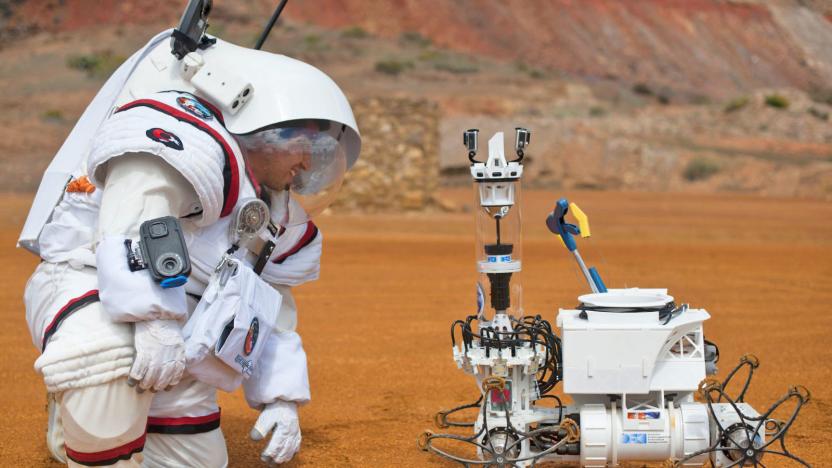cosmicrays
Latest

Scientists trace the origin of high-energy cosmic radiation
This week, the National Science Foundation announced a groundbreaking discovery that provides answers to a question scientists have been asking for decades. A team at the NSF IceCube Neutrino Observatory at the Amundsen-Scott South Pole Station was able to trace the source of high-energy cosmic rays to their source: a blazar, which is a galaxy center that produces massive particle jets, powered by a supermassive black hole.

Students solve a 60-year-old space radiation mystery
Earth's Van Allen Belts are an area of energetic particles that surround our planet and are held in place thanks to Earth's magnetic field. These radiation belts trap charged particles, protecting us from the effects of some of space's most harmful radiation. There are still many mysteries we haven't solved about the Van Allen Belts, but now, students at the University of Colorado Boulder have solved one that dates back 60 years.

Cosmic rays unlock new secrets in Egypt's Great Pyramid
It turns out that the 4,500 year old Great Pyramid of Giza still has some secrets to share. Using cosmic-ray imaging, an international team detected a large chamber within the structure that was previously unidentified, according to Nature. It's the first discovery within the Great Pyramid since the 19th century.

The universe's most energetic particles have traveled a long way
The origin of cosmic rays has been a mystery to scientists since their detection over fifty years ago. One of the prevailing theories is that they come from the center of our galaxy. But now, a group of more than 400 scientists from eighteen different countries has confirmed that this high-energy radiation has its origins outside our galaxy. The results will be published tomorrow in the journal Science.

NASA wants your origami ideas for its spacecraft radiation shield
NASA needs ideas on how to design a radiation shield for deep space vehicles, and it's turning to origami artists and enthusiasts for help. If you're skilled in the art, that includes you. The space agency has teamed up with crowdsourcing website Freelancer to launch a project challenging people to create an origami design showing the most efficient way to pack a radiation shield. It's a necessary component for manned missions, since cosmic rays can damage both human bodies and electronics. Without a shield, future spacefarers will be more prone to developing cancer, degenerative tissue damage, nervous system damage, heart disease and cataracts.

Mars astronauts at greater risk of cancer than previously thought
You might not want to book that trip to Mars just yet. Researchers have published a study estimating that the risk of cancer from cosmic rays is twice as high as previously thought. They've determined that conventional risk models are incomplete. While NASA and other groups believe that radiation-based cancer stems only from direct cell damage and mutations, the new model accounts for the possibility that heavily damaged cells will increase the cancer risk for "bystander" cells. There's a knock-on effect that would be difficult to escape.

NASA's Antarctica balloons will study cosmic rays and neutrinos
Antarctica is ideal for launching high-altitude science balloons this time of year. You not only get non-stop sunlight (ideal for solar power), but wind patterns that keep those balloons over land. And NASA is determined to take advantage of this. It's launching a trio of Antarctic balloon missions that promise to shed light on the mysteries of space. The first to take off, the University of Maryland's BACCUS (Boron and Carbon Cosmic Rays in the Upper Stratosphere), will look at cosmic ray particles to learn about the chemicals and density in the space between stars.

Egypt hunts for hidden pyramid chambers with cosmic rays
Egyptologists, rejoice. A new project was launched on the weekend with the goal of scanning Egypt's pyramids to find secrets about how they were built, and even discover hidden rooms and chambers. The project is headed by Egypt's antiquity ministry, which is heading a team of experts from Japan, France and Canada. The aim is to use infrared scanners and rare, esoteric cosmic ray detectors to map the interior of several pyramids, including the Pyramids of Cheops and Chephren at Giza. The team said it may also use the same technique to prove (or disprove) a theory that the legendary Queen Nefertiti is buried in a chamber next to Tutankhamun.

Scientists want you to find cosmic rays using your phone's camera
Cosmic ray particles hit Earth's atmosphere all the time, but finding them is tough; even the most sophisticated detectors can only cover so much ground. Scientists at University of California might just have discovered an easy way to pinpoint these exotic elements, however: the camera on your smartphone. The team's upcoming CRAYFIS (Cosmic Rays Found in Smartphones) app looks for high energy particles hitting the camera sensor on your device as soon it's both asleep and charging. While one phone wouldn't collect much data by itself, a gaggle of them would be extremely powerful; 1,000 phones in a square kilometer (0.4 square miles) would capture virtually every particle zooming overhead. They could actually be more effective than existing detection arrays, which tend to oversaturate quickly.

Radio astronomy pioneer Sir Bernard Lovell dies at 98
Astronomy just lost one of its vanguards, as Sir Bernard Lovell has died at 98. The UK-born scientist was best known as a cornerstone of radio telescope development. While he wasn't the first to leap into the field, he established the University of Manchester's Jodrell Bank Observatory to study cosmic rays in 1945 and organized the construction of what would ultimately be called the Lovell Telescope -- a radio telescope so large and useful that it's still the third-largest steerable example in the world, 55 years after it was first put into action. His work helped track some of the earliest spacecraft and was instrumental in confirming the first discovered pulsars and quasars. On top of his most conspicuous achievements, Sir Lovell played an important role in developing airborne radar during World War II and was lauded for having scientific curiosity long after he hung up his Jodrell director's hat in 1980. Science will be poorer without him. [Image credit: NASA; thanks, Darren]

$2 billion antimatter detector to go on last shuttle mission, taxpayers agree it better find -something
The airspace above the Atlantic Ocean will get a lot more expensive tomorrow as a U.S. Airforce Galaxy jet transports the Alpha Magnetic Spectrometer -- developed at CERN -- from Geneva to the Kennedy Space Center in Florida. The last-ever Space Shuttle mission in February will transport the AMS to the International Space Station, where it will stay docked for 20 years to "search for antimatter and dark matter by measuring cosmic rays." We're not sure what that means, but we trust it will lead to a microwave that heats the interior of our Hot Pockets while keeping the crust crisp and flaky, bringing us one step closer to World Peace.[Image credit: US Mission Geneva's flickr]

Intel patents cosmic ray detectors on-a-chip. What a relief.
That great perpetrator of worldly ills, the cosmic ray, has at last met its match. Intel has patented the concept of an on-chip detector of cosmic rays which would auto-correct for soft errors caused by the cosmic ray's interference. Apparently Intel is concerned that cosmic rays -- those perky particles from space that blast through the Earth's atmosphere and tamper with your precious bodily fluids -- are going to become "a major limiter of computer reliability in the next decade" as chips get smaller and smaller. The rays have already been proved to interfere with electronics in small ways, so while Intel doesn't have method for building an actual cosmic ray detector yet, they're certainly getting a jump on the problem with this patent. We know we'll certainly be sleeping better at night.[Via Slashdot]





